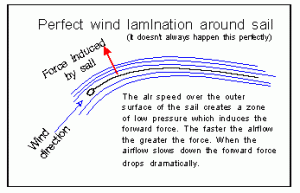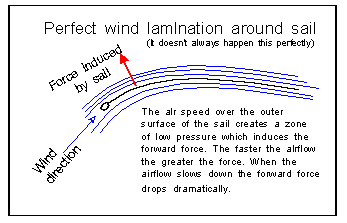Fun Facts – Sails are Wings
Sails are Wings.
 In order for a sail to be efficient, wind has to pass by both sides of the wing. The front side and the back side. In other words, the leading edge of the sail has to be orientated in such a way the the wind is allowed to flow on both sides of the sail. Whether you are letting the sail out (easing), or, pulling the sail in (hardening), the act of trimming the sails has only to do with the orientation of the wing to the prevailing wind.
In order for a sail to be efficient, wind has to pass by both sides of the wing. The front side and the back side. In other words, the leading edge of the sail has to be orientated in such a way the the wind is allowed to flow on both sides of the sail. Whether you are letting the sail out (easing), or, pulling the sail in (hardening), the act of trimming the sails has only to do with the orientation of the wing to the prevailing wind.
The goal of trimming is to allow the leading edge of the wing to be orientated properly to the wind.
Whether the boat is sideways to the wind (beam reach) or heading to wind (close hauled) the wings relationship to the wind remains the same. This is a very important. The boat may point in a different direction at times, but the wing orientation to the wind remains the same. (Unless you are heading down wind and can’t achieve the wing effect).
Air has mass. Its heavy. If you don’t think so I would invite you to try carrying a piece of plywood in any kind of wind. The results are funny… send me a video. By orientating the sail in such a way as to create a wing effect, you bring two forces to bear.
First: The wind that flows around the front of the sail forced to flow in a curve towards the back of the boat. The effect is similar to if you swung a bucket of water on a string. The wind wants to continue in a straight line, it has mass. You are forcing the wind around the corner, and the resulting effect is a low pressure air on the front side of the wing (The top side on an airplane wing)
Second: The wind that flows around the back side of the sail is forced around the curve and effectively piles up into the sail. It is additionally augmented by the causal affect of the low pressure on the front side of your wing.

This cannot be understated. If you fail to create a wing effect, your friends will sail away from you without any obvious reason. We use strings (telltales) located on the front of the foresail to give a visual reference to the wind flow. We use strings (telltales) on the aft edge (luff) of the main for the same reason.

